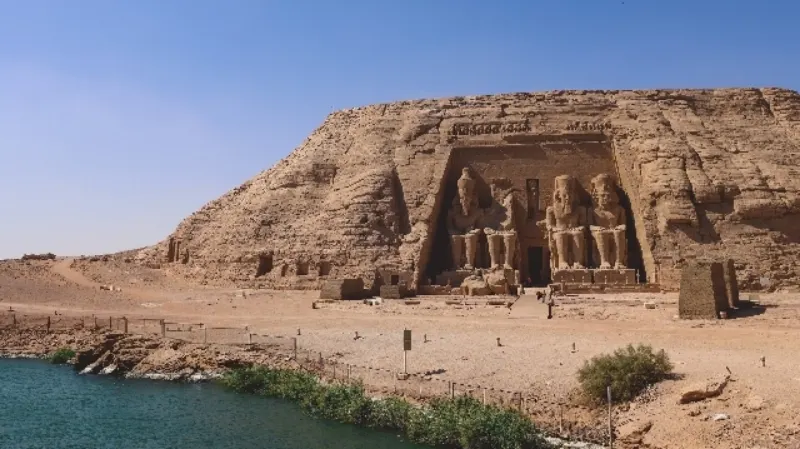Abu Simbel Sun Festival: Egypt’s Incredible Solar Phenomenon
The ancient architects positioned the temple so that sunlight would reach the holiest room on February 22nd, and October 22nd. Know more about Abu Simbel Sun Festival.

The Abu Simbel Temples are among the most iconic and remarkable sites in Egypt. Built by Pharaoh Ramses II in the 13th century BC on the southern edge of his kingdom, these monumental temples marked Egypt’s southern border and impressed foreign visitors. Today, the temples are world-famous not only for their massive statues but also for the extraordinary Abu Simbel light phenomenon that occurs twice a year, making them a must-visit for anyone booking Egypt tours.
History of Abu Simbel Temples
Although these temples appear to honour Ramses II and his wife Nefertari, they are primarily dedicated to the gods.
The larger temple, with four colossal seated statues of Ramses II at the entrance, honours Amun, Ptah, and Re-Harakhty.
The smaller temple is dedicated to Queen Nefertari and celebrates Hathor, highlighting the queen’s extraordinary status alongside the pharaoh.
Carved into a sandstone hillside, the temples are adorned with hieroglyphs documenting Ramses II’s military victories, especially the Battle of Kadesh. The larger temple features a 65-foot seated statue at the entrance and a 108-foot statue inside, overseeing the inner chambers. Its sanctum sanctorum remains in darkness except for two days each year—a demonstration of ancient Egyptian mastery of astronomy, mathematics, and architecture.
The Abu Simbel Light Phenomenon
The ancient Egyptians designed the temples so that sunlight would illuminate the innermost room on February 22nd (Ramses II’s ascension anniversary) and October 22nd (his birthday). Today, this event is known as the Abu Simbel Sun Festival. On these dates, sunlight travels more than 200 feet to reach three of the four statues: Ramses II, Ra (the sun god), and Amun (king of the gods). The fourth statue, Ptah, remains in darkness, symbolizing the god of darkness.
This precise alignment is a testament to the intelligence and ingenuity of the ancient Egyptians. More than 3,200 years later, the Abu Simbel Sun Festival continues to amaze visitors worldwide.
When is the Abu Simbel Sun Festival Held
The Abu Simbel Sun Festival is celebrated twice a year:
- February 22nd – marking Ramses II’s ascension to the throne
- October 22nd – celebrating Ramses II’s birthday
These are the best dates to witness the Abu Simbel light phenomenon and experience the magical moment when sunlight illuminates the temple’s sanctum.

The Sun Festival at Abu Simbel takes place twice a year — on February 22nd (the day Ramses II took the throne) and October 22nd (his birthday). If you’re planning a trip to Egypt, these are the two magical dates when the inner temple lights up.
Relocation and Preservation: An Engineering Marvel
In the 1960s, the construction of the Aswan High Dam threatened to submerge Abu Simbel under Lake Nasser. UNESCO coordinated a global effort to relocate the temples, cutting them into massive blocks and reconstructing them 65 meters higher while maintaining the original orientation. The Abu Simbel light phenomenon still occurs as precisely as it did thousands of years ago—a modern testament to careful preservation.

Customize Your Dream Vacation!
Get in touch with our local experts for an unforgettable journey.
Plan Your Trip
Best Time to Visit Abu Simbel
For travelers seeking an unforgettable experience, the best time to visit Abu Simbel is during the Sun Festival on February 22nd or October 22nd. Early morning visits allow you to:
- Enjoy cooler temperatures
- Secure the best viewing spot for the sunrise
- Witness the incredible solar alignment firsthand
For other months, visiting in the cooler winter season (November–March) is recommended to avoid extreme heat.
Experiencing the Abu Simbel Sun Festival
The Abu Simbel Sun Festival is not just a solar event—it is a full cultural celebration. Thousands of people gather to witness the sunrise lighting up the statues, and the day is filled with traditional music, dance, artisan markets, and local Egyptian cuisine. Visitors connect with both ancient history and contemporary culture.
Sunrise Celebration
Early risers meditate or enjoy quiet reflection while waiting for the sun to illuminate the sanctum. When the statues are bathed in sunlight, a magical atmosphere fills the site. Once the sun moves higher, festivities continue with traditional singing, dancing, and showcases of Nubian craftsmanship.
Cultural Highlights
The festival provides a rare chance to engage with modern Egyptian culture. Guests can interact with artisans, learn about traditional crafts, and sample local delicacies, blending history, science, and culture in a single experience.
You’ll see something incredible — the sunrise traveling 200 feet inside the temple to light up statues of Ramses II, Ra, and Amun. For over 3,200 years, this phenomenon has only happened on these two exact days. It’s proof of the genius of ancient Egyptian architects.
You can fly from Aswan to Abu Simbel in just 30 minutes. Most visitors take an early flight that gives about two hours to explore the temples before heading back. You can also reach Abu Simbel by road, but flying is the fastest and easiest way.
You’ll join crowds before sunrise, waiting for the temple to light up. After the magical moment, the atmosphere turns festive with music, dancing, local food, and cultural performances. It’s both a spiritual and cultural experience you won’t forget.
Absolutely! Even if you can’t visit during the Sun Festival, the Abu Simbel Temples are among the most breathtaking sites in Egypt after the Pyramids of Giza. The colossal statues, detailed carvings, and lakeside setting along Lake Nasser make it worth the journey anytime of the year.












